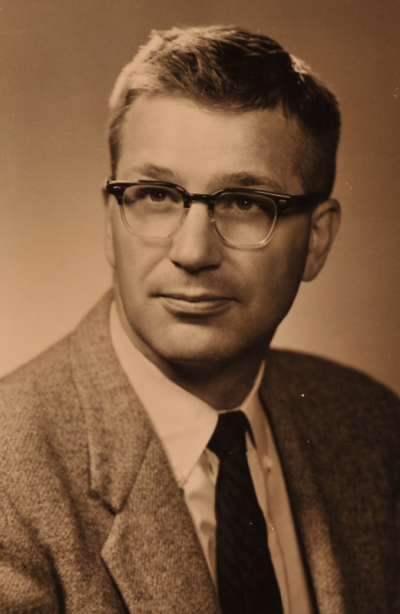
Brian Sproule left a legacy of commitment to Canadian health care. His efforts led to the creation of the province's first pulmonary division at the University of Alberta. He was also known for his dedication to patient care with compassion throughout his extensive career. Photo credit: Medical Photography, University of Alberta Hospital.
When Brian Sproule ('51 MD) returned to Edmonton in 1959, after an extended stay in the United States to further his education, it marked the beginning of a medical legacy that would span more than five decades in Alberta. Sproule would start the first pulmonary division in the province at the University of Alberta and play a key role in how both polio and intensive care patients would be cared for in Alberta in the years to come.
Upon his return trip, Sproule, his wife Marnie and their four children travelled all the way with a Halliburton positive pressure ventilator strapped to the roof of their car. The ventilator was unceremoniously hauled over 3,000 kilometers and would go on to significantly improve the care of polio patients and those with other pulmonary disorders. This unusual trip was only one example of the standard of care and personal effort Sproule put into his work and patients over his fifty-odd year career at the University of Alberta-a career that would leave a lasting mark on the province's patient care.
A passion lived: helping survivors of a polio epidemic
Sproule was drawn to pulmonary medicine during the aftermath of the 1953 polio epidemic. As was the case in other Canadian jurisdictions, Alberta's 1953 epidemic was its largest on record. The province, which typically experienced a yearly average of 81 cases, saw the number of new patients rise to 1,472 that year. Many of those patients were initially cared for at the Royal Alexandra Hospital by physicians Frank Elliott, Nelson Nix and Russell Taylor, who all volunteered their time. Sproule was completing a pathology rotation at the University of Alberta Hospital when he volunteered to help out at the Alex. It was common across Canada for physicians and nurses to lend their skills in response to the polio epidemic without compensation.
In 1954, most of the polio patients were transferred to the U of A Hospital. Sproule was assigned a room on the floor along with another resident, Alvin Mooney. The two shared a room and lived on the ward all of 1954;each of them received $25 a month. Soon after, in anticipation of a growing number of polio cases, the University of Alberta Hospital added a rehabilitation wing for those patients who had passed the acute stage but still required hospital-based care.
While living on the polio ward, Sproule was the first fellow in cardiology at the University of Alberta. He worked with Robert Fraser in the newly-established cardiovascular unit where the first cardiac catheterizations in the province took place, marking a new age of cardiac diagnosis. Sproule also met his wife Marnie MacKay who was a charge nurse on the polio ward.
At the end of 1954, Sproule moved to Dallas to complete a residency under the Marshall Plan, which was named for Mark Marshall and his vision for post-graduate training that served as the foundation for the development of specialities at the University of Alberta Hospital.

When he arrived back in Edmonton five years later with a Halliburton ventilator in tow, Sproule was tasked with looking after all polio patients, including new cases from the smaller 1960 epidemic. He became the director of the newly-created clinical pulmonary division, which was housed within cardiology, and established a pulmonary functions laboratory. In 1967, he helped to develop a respiratory technology course at NAIT, which was unique in Canada. He later served as head of their respiratory technology program for approximately three decades. He and his colleagues established a respiratory home care program, which provided access to equipment and personnel to support patients in their transition from hospital to home.
From polio ward to intensive care unit
Sproule was one of the first individuals at the University of Alberta Hospital, along with Garner King, to recognize the need for an intensive care unit. He chaired an ICU advisory committee and facilitated the opening of a six-bed ICU in an older wing of the hospital. Within a couple of years, polio patients were moved to the Aberhart Hospital and the ICU was expanded into the former polio ward.
"We bought some new equipment [for the ICU] but mostly pooled equipment we had gathered and developed in the polio program," Sproule recounted in an 1985 interview with writer Tony Cashman. "We had some respirators and some cardiac monitors. And a very large number of breathing machines for critically-ill patients."
He, along with Nix, Elliott, Taylor and King, viewed the ICU as a direct legacy of the 1953 polio epidemic and the resulting care at the Royal Alex and University of Alberta Hospital.
Some of the individuals who contracted polio lived in the hospital for more than 30 years. Sproule is remembered for helping to create a sense of family on the ward, and an environment where patients were supported in exploring their hobbies and passions.
Dr. Brian Sproule passed away at the age of 91 on April 15, 2017. His legacy continues to live on.